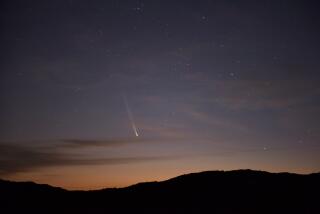Comet ISON puts on a fireworks show in space [Video]
A comet the size of a mountain is zooming toward the sun at 48,000 mph, and the Hubble Space Telescope has caught a bit of its epic journey.
In the image above, and the time-lapse video below, you can see the comet known as ISON zipping between the orbits of Mars and Jupiter, 403 million miles from Earth.
Comet ISON was discovered in September by Russian astronomers Vitali Nevski and Artyom Novichonok who spotted it with the International Scientific Optical Network (ISON). It is a sungrazing comet, which means its orbit will take it very near the sun. It has also been described as a potential “comet of the century” because there is a chance it will shine as brightly in the night sky as the moon soon after it reaches its closest point to the sun at the end of this year.
However, there is also a chance the comet will put on no display at all if it doesn’t survive its close encounter with the sun.
“Comets are notoriously unpredictable,” said Don Yeomans of NASA Near-Earth Object Program in a statement.
The 5-second time-lapse movie below actually represents 43 minutes of Hubble observations. During that time, the comet covered 34,000 miles.
Behind the head of the comet is a tail of dust and gas that is currently hundreds of thousands of miles long. The tail is created as the heat from the sun hits the icy comet, releasing frozen gases and bits of dust.
“The tail is mostly small particles of dust and some water vapor, so what we are seeing is light reflected on what can almost be described as smoke,” said Zoltan Levay, who processes Hubble images for public viewing.
He added that as the comet moves toward the sun, it will bleed even more material from its icy head and its tail will continue to grow. Ultimately, the dusty, smoky tail will be millions of miles long by the time the comet reaches its closest approach to the sun in November.
Take that, fireworks.







